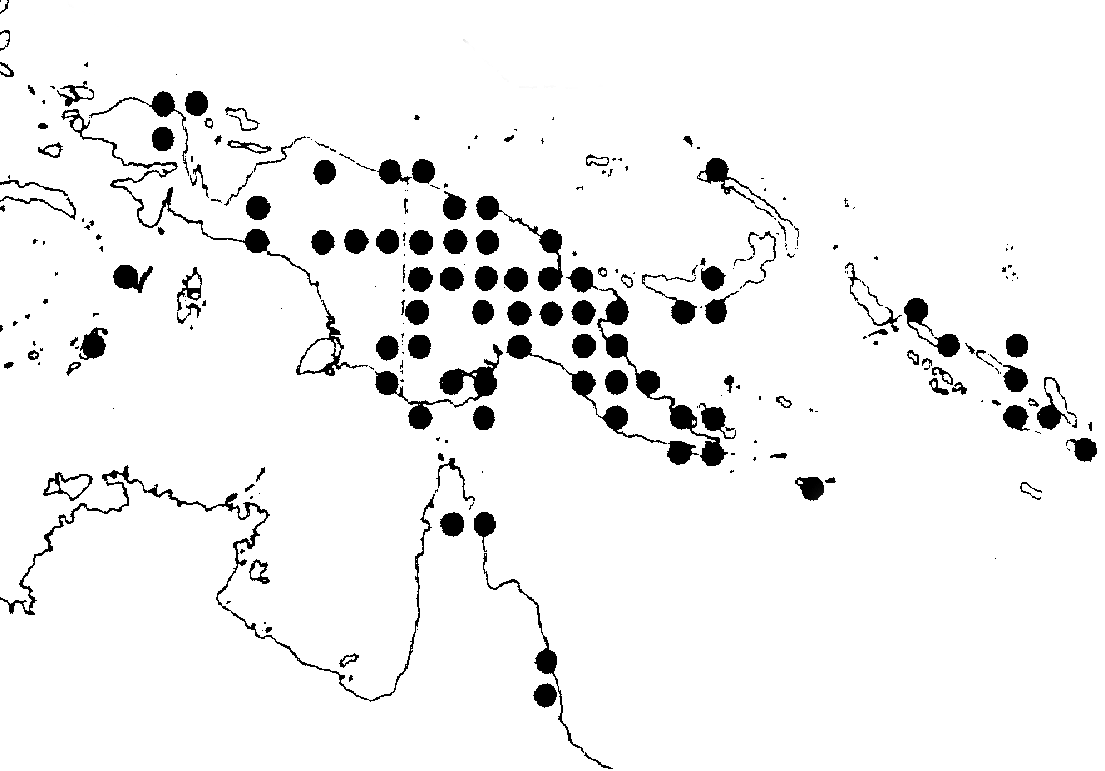
Distribution Map

Description (Barlow 1993)
Loranthus hollrungii Schumann in Schumann & Hollrung, Fl. Kaiser Wilh. Land (1889) 105. Decaisnina hollrungii (Schumann) Barlow, Austral. J. Bot. 14 (1966) 434. - Type: Hollrung 659 (holo B; iso K), New Guinea, Augustafluss, vii.1887.
For descriptions and extensive synonymy see Barlow, Austral. J. Bot. 22 (1974) 538; Flora of Australia 22 (1984) 75. Decaisnina hollrungii has few specialized characters and thus presents a relatively generalized facies for the genus. The species can be identified locally by its combination of robust habit, stems often sharply 2- or 4-angled, distinctly petiolate bifacial leaves glossy on the upper surface and dull below, corolla mostly more than 30 mm long, not inflated at the base, and anthers equal to the free parts of the filaments. The flower colours are variable but most commonly red in the lower part and yellow and/or green above; sometimes the lower part of the corolla is yellow or green, but even then the corolla is usually 2-coloured.
Decaisnina hollrungii is widespread throughout the New Guinean mainland and extends to adjacent islands including Tanimbar and Kei (Moluccas), New Britain and New Ireland, several of the Solomon Islands, and to Cape York Peninsula, Queensland (Fig. 1; 179 collections examined), usually at elevations from sea level to 2000 In, but recorded as high as 2900 m. It is very common in rain forests, parasitic on a range of dicotyledonous hosts too numerous to itemize, but recorded frequently on Ficus.
The affinities of D. hollrungii appear to be with the other Australian and several New Guinean species with which it shares a non-inflated corolla base, relatively long corolla, and triads evenly spaced along the inflorescence axis. Its further affinities are possibly with D. sumbawensis from which it differs in being more robust, with more angular stems, generally larger leaves, and longer corollas not inflated at the base. Decaisnina sumbawensis has an area which straddles Charles's Line and is contiguous with that of D. hollrungii, thus indicating a possible origin of the latter species (see note under D. sumbawensis).
Description (Barlow 1974)
Glabrous or more frequently with the undersides of the leaves shortly and sparsely brown-tomentose, rarely with the tomentum denser and extending to the petioles, young stems, and inflorescences. Stems flattened and angular to winged when young, terete to strongly quadrangular when older. Petiole distinct, 5-30 mm long; lamina lanceolate to ovate (mostly broad lanceolate to narrow ovate), (5)-8-18-(25) by (1.5)-4-8-(12) cm, mostly lustrous or shining above, dull below, (attenuate to) abruptly contracted to slightly cordate at the base, recurved at the margin, acute or obtuse at the apex; venation pennate, obscure or distinct but with the midrib prominently raised below. Inflorescences mostly 1 or 2 in the axils; axis very variable, bearing triads in 5-14 pairs distributed all the way along the axis, enlarging in fruit and reaching 12 cm in length; peduncles of the triads 1 5-8 mm long; lateral flowers of the triads usually sessile but sometimes on pedicels up to 3 mm long; bracts mostly obtuse, c. 1 5 mm long. Calyx narrow cylindrical, 25-5 mm long; limb variable at the margin, up to 2 mm long. Corolla in the mature bud (25)-30-40-(60) mm long; petals in the open flower coherent in the lower 1-8 mm. Anthers 3-4-(6) mm long, equal to or slightly longer than the free parts of the filaments. Style articulate close to the base. Fruit almost globular. Chromosome Number.- n = 12 (Barlow 1966).
Occurrence. New Guinea, New Britain, New Ireland, and the Solomon Islands (Fig. 3), mostly between 0 m and 2000 m altitude, but occasionally recorded up to 2900 m. The species also occurs in northern Queensland. It is abundant in many areas, and is a frequent parasite of roadside trees and cultivated plants.
Representative Specimens.
WEST IRIAN: Son Village, Vogelkop Peninsula, 650 m alt., van Royen and Sleumer 7527, 27.x.1961 (L); Wissel Lakes Region, Eyma 4462, 28.i.1939 (L); Janim besar SW. of L. Sentani, 70 m alt., van der Sidle BW 5531, l0.viii.1957 (cANS); Merau R. between Djcdjoeroek and Eramboe, 30 m alt., van Royen 4810, 25.viii.1954 (CANS).
EASTERN NEW GUINEA: L. Daviumbu, Fly R., Brass 7597, Aug. 1936 (L); Leitre Village, Sepik District, 0 m alt., Sayers NGF 18058, 13.iii.1964 (CANB; L); Uinba, Nona-Minj Divide, 1970 m alt., Vink 16381, 24.viii.1963 (CANS; L); near Kumul Mission, Chuave-Chimbu Road, 1800 m alt., Womersley NGF 14130, 1.viii.1951 (L); Pengagl Creek, Chimbu Subdist., 2900 m alt., Miller and Sayers NGF 23783, 26.viii.1964 (LAE; L); North Sagarai Valley, Milne Bay, 75 m alt., Henty NGF 16873, 31.v.1964 (CANB); Joe Landing, Sudest 1., 150 m alt., Brass 27767, 19.viii.1956 (CANB).
NEW BRITAIN: Torlu R., Gasmata, 1050 m alt., Sayers NGF 24240, 25.iii.1965 (AD).
NEW IRELAND Kavieng, Millar NGF 23818, 31.x.1964 (LAE).
SOLOMON ISLANDS: Bougainville, S. foothill slopes of L. Loloru crater c. 17 miles N. of Bum, 800 m alt., Schodde and Craven 3729, 1.viii.1964 (CANB).
Decaisnina hollrungii is one of the most polymorphic loranth species in the region. It has a 'weedy' character, being found commonly on cultivated hosts and in disturbed habitats. Because there is no regular geographic pattern of distribution of variants, no distinction of subspecies or varieties has been made. The only indication of ecogeographic divergence lies in the relatively small parts, particularly leaves, of collections from higher elevations. Many entities treated as species by earlier workers with limited materials at their disposal merge in the seemingly continuous range of variability of the species. Some of the extreme variants approach other species in the genus, and may perhaps he introgressive forms. Specimens from the Solomon Islands, including the type of D. angustifolia, show some characters of D. forsteriana and some from New Guinea are close to D. djamuensis or D. parvifolia. A species diagnosis which includes all of the extreme variations becomes almost meaningless, and the above description, although broad, may not adequately cover all forms. It is not expected, therefore, that the key or description will be adequate for all collections ef Decaisnina.
Illustrations
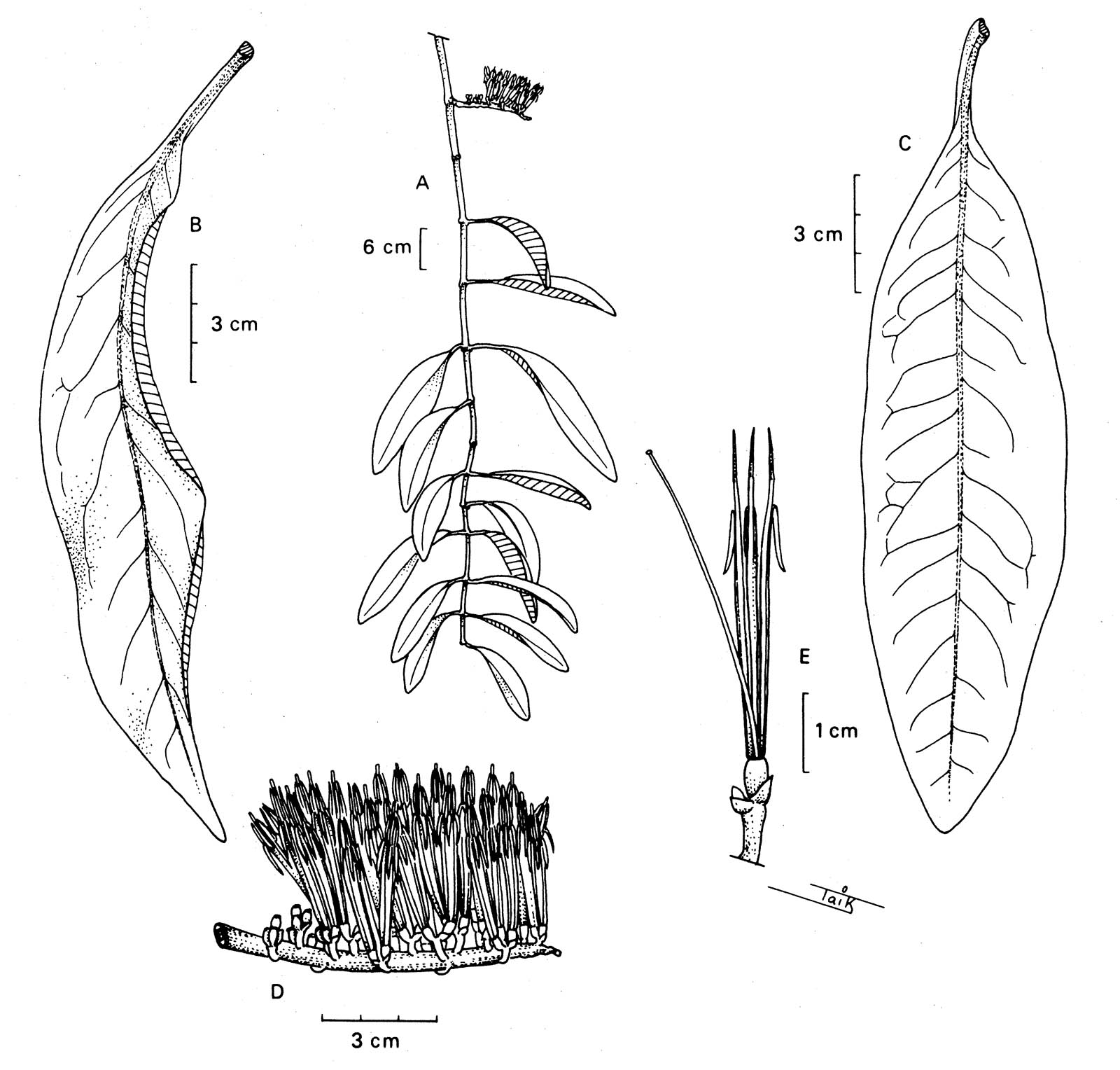
Decaisnina hollrungii A - branch. B - leaf. C - leaf (flattened). D - inflorescence. E - flower. From Barlow (1981).
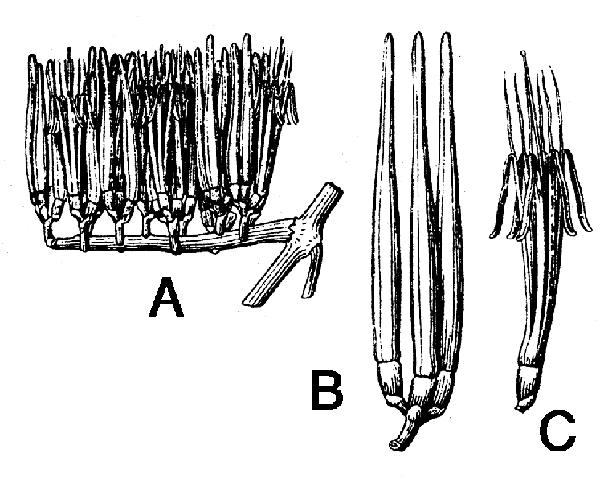
Decaisnina hollrungii (as Amylotheca versteegii). A - Inflorescence. B - triad in bud. C - flower. From Danser (1931).
Photographs
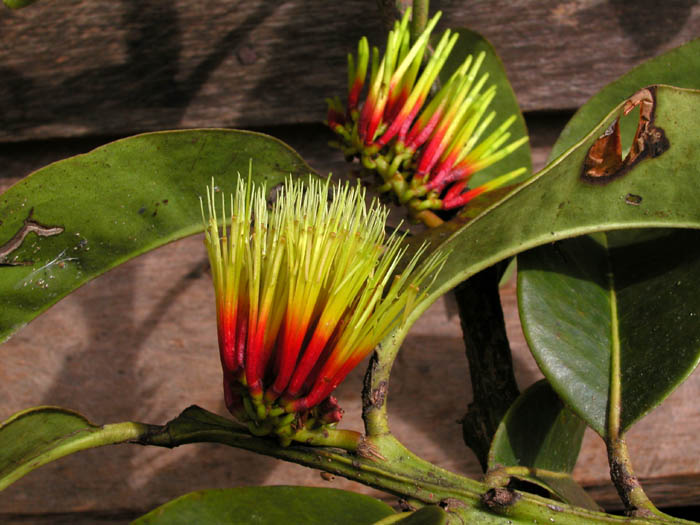
Inflorescences (DLN 4465). Morobe District, Finschhafen Subdistrict, Nanduo Village, Papua New Guinea. 3285 ft (1001 m) elev. Parasitic on Syzygium. Photo by Dan Nickrent.
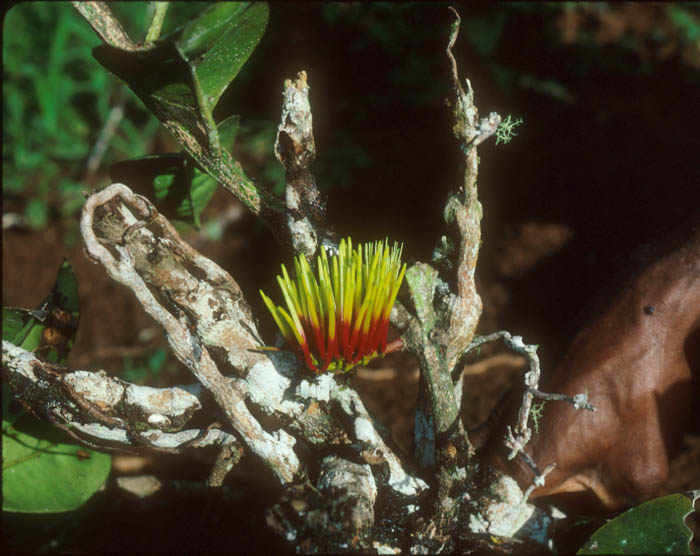
Same collection as above (DLN 4465) showing floral buds and haustorial attachment to host. Photo by Dan Nickrent.
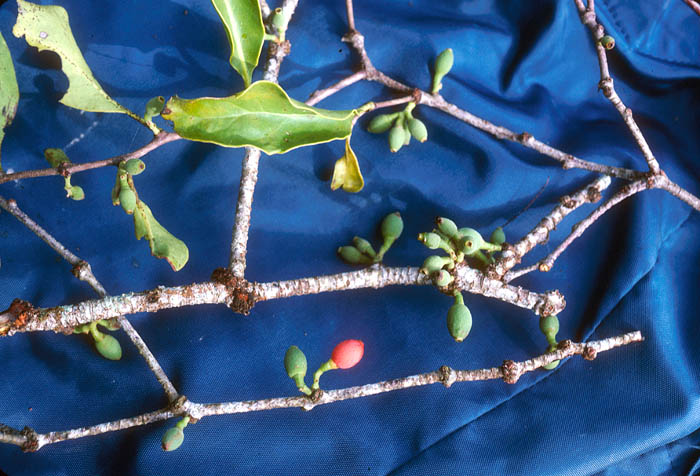
Decaisnina hollrungii (DLN 2823) in fruit. Photo taken SE of Daintree River, Queensland, Australia by Dan Nickrent.
Decaisnina hollrungii
updated 20 January 2007